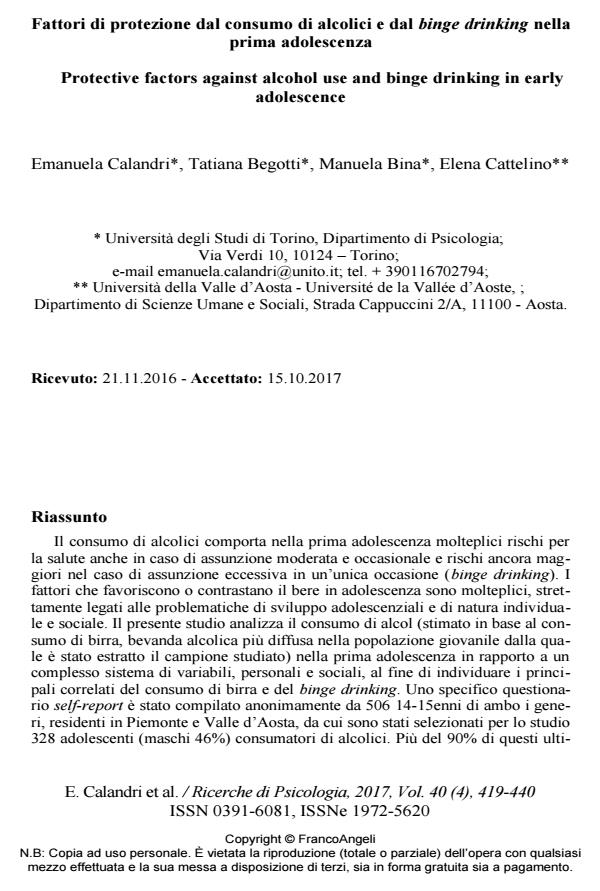Protective factors against alcohol use and binge drinking in early adolescence
Journal title RICERCHE DI PSICOLOGIA
Author/s Emanuela Calandri, Tatiana Begotti, Manuela Bina, Elena Cattelino
Publishing Year 2017 Issue 2017/4
Language Italian Pages 22 P. 419-440 File size 229 KB
DOI 10.3280/RIP2017-004003
DOI is like a bar code for intellectual property: to have more infomation
click here
Below, you can see the article first page
If you want to buy this article in PDF format, you can do it, following the instructions to buy download credits

FrancoAngeli is member of Publishers International Linking Association, Inc (PILA), a not-for-profit association which run the CrossRef service enabling links to and from online scholarly content.
During early adolescence alcohol use entails multiple risks for health, even in case of moderate and occasional consumption. The risk severity increases in case of the intake of an excessive dose of alcohol in a single session (binge drinking). Literature shows several personal and social factors which could favour (risk factors) or limit (protective factors) adolescents’ drinking. This study investigates alcohol consumption (in particular beer consumption, the most used alcoholic drink in the young population from which the sample was selected) in early adolescence and its relationship with a complex system of personal and social variables in order to identify the main correlations of beer consumption and binge drinking. A self-report questionnaire was completed anonymously by 506 boys and girls, aged 14-15 years, living in the Regions of Piedmont and Aosta Valley (North-West of Italy); 328 adolescents (46% males) were selected for the study as drinkers. More than 90% of drinkers, in greater number males and 15-year-old adolescents, had drunk beer in the last two months whereas 31% were involved in at least one episode of binge drinking in the same period, without statistically significant differences by gender or age. Both beer consumption and binge drinking were mainly explained by social factors such as drinking with friends and also drinking with parents. Among personal variables, greater self-regulatory efficacy predicted minor involvement in both beer consumption and binge drinking. The results suggest that prevention programs, in this age group, should focus not only on individuals and peer groups but also on families by involving parents.
Keywords: Alcohol, binge drinking, early adolescence, protective factors, risk, self-regulatory efficacy.
- Stili educativi genitoriali, benessere scolastico e rendimento scolastico in adolescenza Maria Giulia Olivari, Eleonora Mascheroni, Gaia Cuccì, Emanuela Confalonieri, in RICERCHE DI PSICOLOGIA 1/2019 pp.9
DOI: 10.3280/RIP2019-001001
Emanuela Calandri, Tatiana Begotti, Manuela Bina, Elena Cattelino, Fattori di protezione dal consumo di alcolici e dal binge drinking nella prima adolescenza in "RICERCHE DI PSICOLOGIA " 4/2017, pp 419-440, DOI: 10.3280/RIP2017-004003